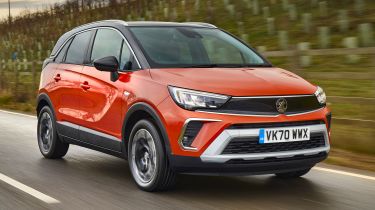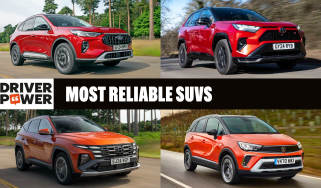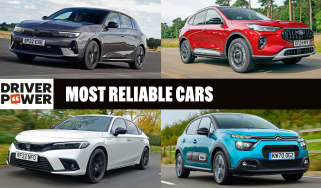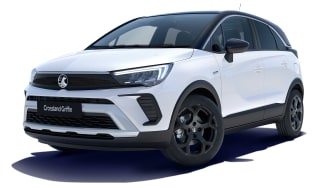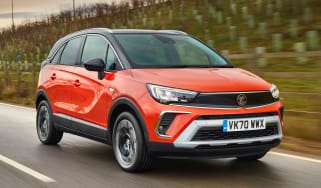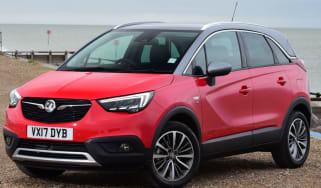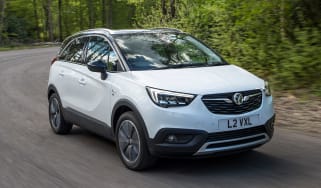Vauxhall Crossland (2017-2024) review
The Vauxhall Crossland SUV offers good family practicality, but isn't as sharp to drive or efficient as some rivals

The Vauxhall Crossland is a spacious, practical, and economical family car that received a number of improvements thanks to a midlife overhaul in 2020. It can't quite match the striking looks of its smaller Mokka sibling, but the Crossland has a smart appearance and additional versatility that’ll fit in well with modern family life.
The refresh also saw updates to the Crossland's steering and suspension set-up, but all that can’t disguise the fact that Vauxhall’s small SUV is based on a previous generation Peugeot 2008, and is being left behind by key rivals that have embraced hybrid technology in the pursuit of higher fuel economy.
About the Vauxhall Crossland
The Vauxhall Crossland isn't so much a bold 4x4, but more of a car aimed at young families with an active lifestyle. It sits somewhere between the mid-size Grandland and more compact Mokka SUVs in Vauxhall's line-up, with rivals in the small SUV market spanning far and wide.
For starters, there's the Citroen C3 Aircross on which the Crossland is based, the hugely successful Nissan Juke, the fun-to-drive Ford Puma and our Small SUV of the Year for 2023, the Hyundai Kona. Other models you should consider in this segment include the Renault Captur, Toyota Yaris Cross and the Kia Niro. The Volkswagen T-Cross and Skoda Kamiq also have the Crossland in their crosshairs.
Used - available now

2024 Nissan
Ariya
12,471 milesAutomaticElectric
Cash £25,490
2021 Lexus
UX 300e
39,392 milesAutomaticElectric
Cash £16,950
2023 Hyundai
i30
23,040 milesManualPetrol1.0L
Cash £14,801
2021 Vauxhall
Mokka
16,283 milesAutomaticPetrol1.2L
Cash £15,795Unlike the majority of its rivals, which now offer or even come with hybrid technology as standard, the Crossland is available exclusively with a 1.2-litre turbocharged three-cylinder petrol engine, paired with either a six-speed manual or automatic gearbox.
The Crossland was initially offered with a wide range of trims to provide something to suit everyone, but with the onset of the new Vauxhall Frontera coming to replace the Crossland, the trim offerings have been cut to just the top-of-the-range Ultimate.
While not the best value, Ultimate does at least come loaded with everything, including automatic LED headlights, front and rear parking sensors, an advanced park assist system, keyless entry and start, and heated seats. The interior is also tweaked with Alcantara, which makes the Crossland feel a little more upmarket.
Engines, performance and drive
As part of the Crossland's rather significant facelift in 2020, the small SUV received revised suspension and steering settings to make it feel better to drive, more comfortable, and more stable on motorways. The Crossland was never the best handling family car to begin with, and even with the new dampers and updated steering, it’s still not as fun to drive as a Ford Puma, nor can it beat the Volkswagen T-Cross for comfort.
In fact, we found the updated Crossland’s ride to be noticeably firm at low speeds, but the car did feel more stable and composed on faster roads. At motorway speeds, the Crossland is quite refined, although the wind noise we encountered means it’s not the quietest small SUV out there, and tyre roar is still an issue.
On a positive note, the engine line-up stands up well to scrutiny. Both the 108bhp and 128bhp versions of the 1.2-litre turbocharged three-cylinder petrol feel strong, with plenty of mid-range pulling power that makes getting up to speed easy. The manual gearbox is vague, but the ratios are well-judged. However, the auto can be a little jerky in town (it’s better with the start/stop system turned off) and there’s no four-wheel drive option despite the Crossland’s raised body and SUV appearance.
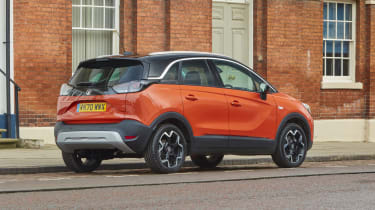
0-62mph acceleration and top speed
The Crossland is only available with a 1.2-litre turbocharged three-pot petrol engine, producing either 108bhp when paired with a six-speed manual gearbox or 128bhp if you spring for the six-speed auto 'box. The less potent set-up takes 10.5 seconds to do 0-62mph and will hit 116mph flat out, while the 128bhp version with its automatic transmission manages the same benchmark sprint in 9.9 seconds with a 125mph maximum.
We expect most people will be happy with the base combo because it copes admirably with town driving and longer motorway trips alike. It's the more economical of the two options on paper, which is a handy bonus. Both versions get fuel-saving stop-start technology.
MPG, CO2 and running costs
Unlike some of Vauxhall's other models that have adopted electric power and hybrid technology, the Crossland has only ever been offered with petrol or diesel engines. The line-up has been reduced to just one engine: a 1.2-litre turbocharged petrol, and the only clever fuel-saving technology it has is a stop-start system to prevent wasting fuel idling at traffic lights.
Our pick of the petrol range is the 108bhp engine paired with a six-speed manual gearbox. According to Vauxhall, this combination will return up to 48mpg with CO2 emissions of 134g/km. Opt for the 128bhp automatic version, and you’ll see fuel economy drop to 44.1mpg, while CO2 rises to 144g/km.
With figures like those, the Crossland competes well with the standard Nissan Juke or Renault Captur. However, it doesn't come close to the fuel efficiency you can expect from a Kia Niro Hybrid, Toyota Yaris Cross or Renault Captur E-Tech.
Insurance groups
The current Crossland lineup ranges between insurance groups 16 and 19. Opting for the automatic gearbox will land you in group 19, while a 1.2-petrol with a manual gearbox will be the cheapest to insure in group 16.
Standard security equipment across all models includes electronically protected audio and infotainment hardware, a luggage area cover, an immobiliser system and remote central locking.
Depreciation
Vauxhall products haven't always been the best at retaining value in the second-hand market. This isn't great news if you've bought a brand-new vehicle, but it does make for a bargain if you're looking at a used model.
Our expert data suggests the Crossland won’t fare well, retaining around 38 per cent of its value over three years and 36,000 miles.
To get an accurate valuation on a specific model check out our free car valuation tool
Interior, design and technology
The original Crossland X indirectly replaced the ageing Meriva MPV, and the facelifted Crossland continues as an MPV-inspired small SUV, sharing a platform, engines and technology with the Citroen C3 Aircross. Some MPV influences are still evident, particularly at the rear. That’s because the Crossland is positioned as a more versatile and practical proposition than other B-segment crossovers, and as such, the exterior shape is dictated by space requirements in the cabin.
With the wheels pushed right out to the corners, plus that tall, boxy roofline and a steeply raked windscreen stretching far out in front of the dashboard, the Crossland feels spacious and airy inside. Headroom is excellent, while legroom in the back is also very good for this segment.
Overall, though, the Crossland’s cabin prioritises function over form. It’s been cleverly designed and packaged to maximise space, and comes well-equipped, too. But there’s little in the way of flair, and despite a midlife makeover, some of the plastics on show remain hard and scratchy to touch.
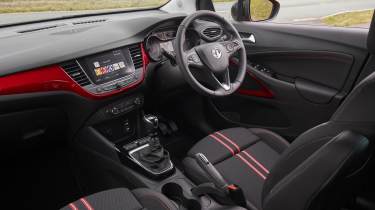
Sat-nav, stereo and infotainment
Every Crossland comes with a colour touchscreen in the centre of the dash, plus Apple CarPlay and Android Auto smartphone connectivity, Bluetooth, a DAB radio and a USB connector. With the demise of the entry-level Design model, every Crossland comes with an 8-inch screen with sat-nav built-in.
Either way, the touchscreen is angled towards the driver, and we found the set-up to be fairly slick and easy to use, with decent response to touches and a row of chunky physical buttons to help navigate the sub-menus. A six-speaker audio setup with steering-wheel-mounted controls also comes as standard.
Practicality, comfort and boot space
Practicality is a strong point for the Vauxhall Crossland. The tall, upright and square body means there’s loads of room inside for passengers and luggage, with plenty of storage solutions dotted about the cabin. It’s only available with five seats, but there should be more than enough space for most families.
The driving position is good and extremely comfortable over long distances due to its elevated stance and supportive seats with standard driver’s lumbar adjustment. The car’s large glasshouse makes the cabin feel light and airy, but the way the dashboard stretches out ahead of you can make parking tricky. The short rear overhang helps to mitigate this issue, while the rear sensors and camera should help limit any dings and dents for less confident drivers.
Dimensions and size
At 4,212mm long, the Crossland is comparable to the Nissan Juke, although the Vauxhall is a little narrower at 1,776mm to the Nissan's 1,800mm. Compared to the Kia Niro, the Crossland is slightly shorter and narrower, but it's taller at 1,605mm, while the Niro measures 1,585mm.
Leg room, head room & passenger space
There is no denying that the Crossland is a practical car. In the transition from MPV to SUV, the versatile family car has lost none of its family-friendly flair. There is loads of room up front, while in the back, you’ll find space for three adults thanks to the fact that there’s plenty of head and shoulder room.
All cars have a 60:40 split-folding rear seat configuration, while the top-of-the-range Ultimate version gets a sliding function for the bench, which allows passengers to prioritise legroom or cargo area depending on the situation. All versions come with ISOFIX points on the outer positions of the rear seats.
Boot Space
The 410-litre boot is big for this class, and it expands to 1,255 litres with the rear seat folded flat. The bench can be moved forward by 150mm if more space in the boot is required without sacrificing passenger carrying.
However, the Volkswagen T-Cross also has this sliding rear seat trick and has the edge over the Crossland by offering 455 litres of space.
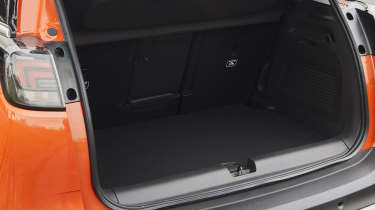
Reliability and safety
The (pre-name change) Crossland X was crash-tested by Euro NCAP in 2017 and received a full five-star rating, achieving 85 per cent and 84 per cent for adult and child safety, respectively. However, that rating has since expired due to the test having become much more stringent. That’s not to say the Crossland wouldn’t protect you in a crash, but there are newer rivals that might protect you even better.
Reliability shouldn’t be too concerning because the Crossland uses plenty of tried and tested parts. This particular small Vauxhall SUV didn't feature in our 2023 Driver Power owner satisfaction survey, but its Mokka sibling saw a 75th place finish out of 75 cars in the best cars to own rankings. Vauxhall, as a manufacturer, slipped down the best brands poll, falling from 19th position in 2022 to 24th in 2023. However, Vauxhall did still rank above rival brands Volkswagen and Ford.
Warranty
Vauxhall used to offer a lifetime warranty on its cars, limited to the first owner. However, the brand has since scrapped this plan because the way in which many people buy cars has seen customers change models much more frequently. As a result, all Crossland models come with a standardised three-year/60,000-mile warranty. Owners can extend this for an additional fee.
Servicing
All Vauxhall Crossland models are subject to annual or 12,500-mile service intervals, whichever comes soonest. The brand offers servicing plans with fixed monthly costs, including two years of roadside assistance cover and your first MOT free.

